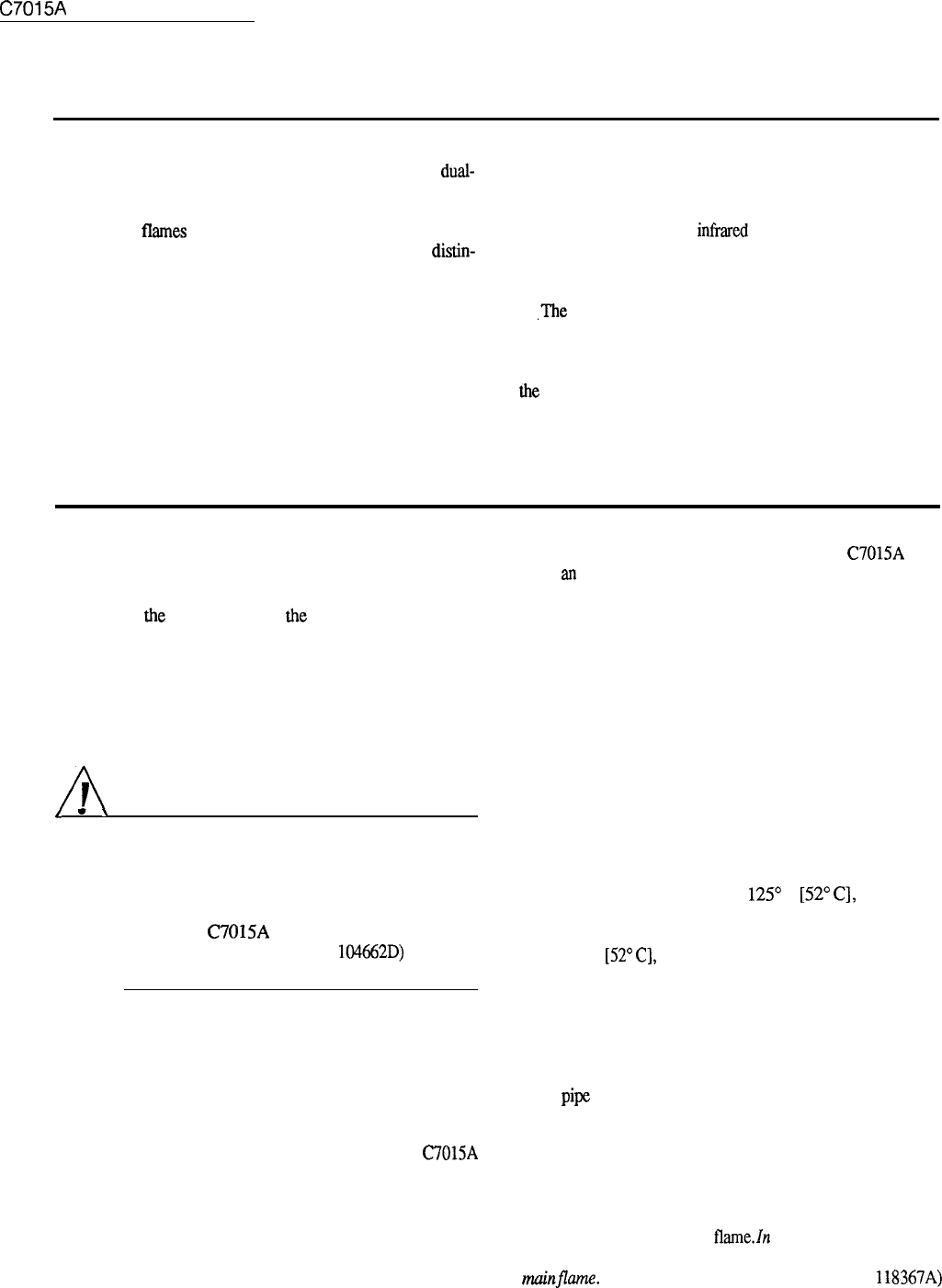
C7015A
OPERATION
l
INSTALLATION
Operation
OPERATION OF INFRARED DETECTORS
Infrared detectors can be used with gas, oil, coal, or
dual-
fuel flames. Since more than 90% of the total flame radiation
is infrared, these detectors receive ample radiation and can
detect weak
fkunes
as well as flames of higher intensity.
The lead sulfide cell used in the detector cannot
diitin-
guish between the infrared radiation emitted by hot refrac-
tory and the infrared radiation from a flame. Therefore, the
infrared detection system includes an amplifier that re-
sponds only to the flickering characteristic of flame radiation
and rejects the steady radiation characteristic of hot refrac-
tory.
Unfortunately, smoke or fuel mist within the combustion
chamber can intermittently reflect, bend, or block the hot
refractory radiation, thus making it fluctuate. This fluctuating
action can simulate the flickering radiation from a flame,
and infrared radiation may be present even after the
refractory has visibly stopped glowing. Therefore, be very
careful when applying an
infrared
detection system to be sure
it responds only to flame.
CELL CONSTRUCTION
,The
photosensitive material used in the infrared detector
is lead sulfide. The electrical resistance of lead sulfide de-
creases when exposed to infrared radiation. If a voltage is
applied across the lead sulfide photocell, current flows when
the
cell is exposed to infrared radiation.
Installation
WHEN INSTALLING THIS PRODUCT.. .
1. Read these instructions carefully. Failure to follow
them could damage the product or cause a hazardous condi-
tion.
2. Check
the
ratings given in
the
instructions and on the
product to make sure the product is suitable for your applica-
tion.
3. Installer must be a trained, experienced flame safe-
guard control service technician.
4. Afterinstallationiscomplete,checkoutproductopera-
tion as provided in these instructions.
A
!
CAUTION
(
I
\
1. Disconnect power supply before beginning in-
stallation to prevent electrical shock and equip-
ment damage, there may be more than one
disconnect.
2. All wiring must be NBC Class 1 (line voltage).
3. Use the
C7015A
only with Honeywell lead
sulfide photocells (part no.
104662D)
and flame
signal amplifiers specified, (see Table 6).
Proper flame detector installation is the basis of a reliable
flame safeguard installation. Refer to the burner manufac-
turer instructions and instructions below. Carefully follow
instructions for the best possible flame detector application.
BASIC REQUIREMENTS
Because all flames produce infrared radiation, a
C7015A
Infrared (lead sulfide) Flame Detector can be used to prove
the presence of a flame in a combustion chamber. The
detector is mounted outside the combustion chamber. Screw
themountingcollartooneendofasightpipeinsertedthrough
the wall of the combustion chamber. The lead sulfide photo-
cell in the detector sights the flame through the sight pipe.
When a flame is present, the lead sulfide photocell
detects the infrared radiation generated. The
C7015A
pro-
duces
an
electric
signal that is sent to the amplifier in the flame
safeguard control. The amplified signal pulls in the flame
relay in the flame safeguard control to allow proper operation.
Because it is necessary for the detector to actually see the
flame, it is best to locate the detector as close to the flame as
physical arrangement, temperature, and other restrictions
permit. These restrictions are described in detail below.
DETERMINE THE LOCATION
Before beginning the actual installation, determine the
best location for mounting the flame detector. Carefully
consider the factors discussed in this section before establish-
ing the location.
TEMPERATURE
The
sensitivity of the lead sulfide cell decreases as its
temperature increases. Up to
125’
F
[52’
Cl,
the loss in
sensitivity is negligible, but temperatures above this point
must
be avoided.
Under normal temperature conditions (be-
low 125” F
[.52’
Cl,
the life of the lead sulfide cell should be
unlimited. The quickest check for excessive temperature is
simply to grasp the detector-it should not be too hot to hold
comfortably in your bare hand.
Several methods are available for cooling the lead sulfide
photocell including ventilating the sight pipe and installing a
pipe nipple, seal-off adapter, and/or heat block between the
sight
pipe
and the detector. Refer to Installing Accessories,
page 8.
SIGHTING
The
infrared detector must continually sight a stable
portion of the flame being detected. The detector is com-
monly applied to detect both the gas pilot and main gas flame,
or thegaspilot and main oil
flame.ln
either case, the detector
must be carefully aimed at the intersection of the pilot and
muinflame.
A Swivel Mount (Honeywell part no.
118367A)
4

















